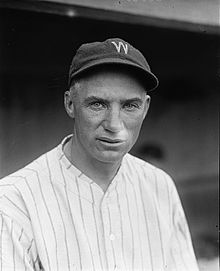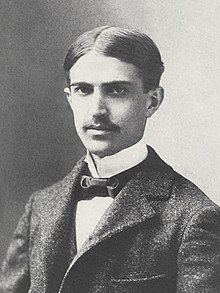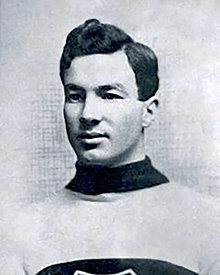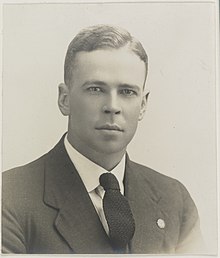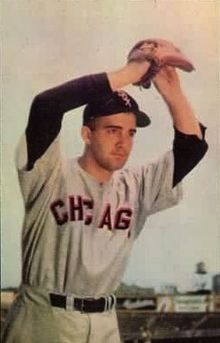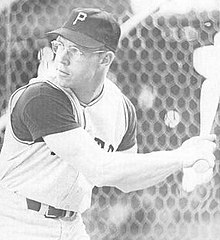Portal:Baseball
Portal maintenance status: (June 2018)
|
| Main page | Content, Categories & Topics | WikiProjects & Things you can do |
The Baseball Portal
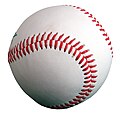
Baseball is a bat-and-ball sport played between two teams of nine players each, taking turns batting and fielding. The game occurs over the course of several plays, with each play generally beginning when a player on the fielding team, called the pitcher, throws a ball that a player on the batting team, called the batter, tries to hit with a bat. The objective of the offensive team (batting team) is to hit the ball into the field of play, away from the other team's players, allowing its players to run the bases, having them advance counter-clockwise around four bases to score what are called "runs". The objective of the defensive team (referred to as the fielding team) is to prevent batters from becoming runners, and to prevent runners' advance around the bases. A run is scored when a runner legally advances around the bases in order and touches home plate (the place where the player started as a batter).
The opposing teams switch back and forth between batting and fielding; the batting team's turn to bat is over once the fielding team records three outs. One turn batting for each team constitutes an inning. A game is usually composed of nine innings, and the team with the greater number of runs at the end of the game wins. Most games end after the ninth inning, but if scores are tied at that point, extra innings are usually played. Baseball has no game clock, though some competitions feature pace-of-play regulations such as the pitch clock to shorten game time.
Baseball evolved from older bat-and-ball games already being played in England by the mid-18th century. This game was brought by immigrants to North America, where the modern version developed. Baseball's American origins, as well as its reputation as a source of escapism during troubled points in American history such as the American Civil War and the Great Depression, have led the sport to receive the moniker of "America's Pastime"; since the late 19th century, it has been unofficially recognized as the national sport of the United States, though in modern times is considered less popular than other sports, such as American football. In addition to North America, baseball spread throughout the rest of the Americas and the Asia–Pacific in the 19th and 20th centuries, and is now considered the most popular sport in parts of Central and South America, the Caribbean, and East Asia, particularly in Japan, South Korea, and Taiwan. (Full article...)
 Featured articles - load new batch
Featured articles - load new batch
-
Image 1Rogers Hornsby tags out Babe Ruth who is caught attempting to steal second base, ending the 1926 World Series.
The 1926 World Series was the championship series of the 1926 Major League Baseball season. The 23rd edition of the Series, it pitted the National League champion St. Louis Cardinals against the American League champion New York Yankees. The Cardinals defeated the Yankees four games to three in the best-of-seven series, which took place from October 2 to 10, 1926, at Yankee Stadium and Sportsman's Park.
This was the first World Series appearance (and first National League pennant win) for the Cardinals, and would be the first of 11 World Series championships in Cardinals history. The Yankees were playing in their fourth World Series in six years after winning their first American League pennant in 1921 and their first world championship in 1923. They would play in another 36 World Series (and win 26 of those), as of the end of the 2023 season. (Full article...) -
Image 2
Mariano Rivera (born November 29, 1969) is a Panamanian-American former professional baseball pitcher who played 19 seasons in Major League Baseball (MLB) for the New York Yankees, from 1995 to 2013. Nicknamed "Mo" and "Sandman", he spent most of his career as a relief pitcher and served as the Yankees' closer for 17 seasons. A thirteen-time All-Star and five-time World Series champion, he is MLB's career leader in saves (652) and games finished (952). Rivera won five American League (AL) Rolaids Relief Man Awards and three Delivery Man of the Year Awards, and he finished in the top three in voting for the AL Cy Young Award four times. He was inducted into the Baseball Hall of Fame as part of its class of 2019 in his first year of eligibility, and is to date the only player ever to be elected unanimously by the Baseball Writers' Association of America (BBWAA).
Raised in the modest Panamanian fishing village of Puerto Caimito, Rivera was an amateur player until he was signed by the Yankees organization in 1990. He debuted in the major leagues in 1995 as a starting pitcher, before permanently converting to a relief pitcher late that year. After a breakthrough season in 1996 as a setup man, he became the Yankees' closer in 1997. In the following seasons, he established himself as one of baseball's top relievers, leading the major leagues in saves in 1999, 2001, and 2004. Rivera primarily threw a sharp-moving, mid-90s mile-per-hour cut fastball that frequently broke hitters' bats and earned a reputation as one of the league's toughest pitches to hit. With his presence at the end of games, signaled by his foreboding entrance song "Enter Sandman", Rivera was a key contributor to the Yankees' dynasty in the late 1990s and early 2000s that won four championships in five years. He was an accomplished postseason performer, winning the 1999 World Series Most Valuable Player (MVP) Award and the 2003 AL Championship Series MVP Award, while setting postseason records that included lowest earned run average (ERA) (0.70) and most saves (42). (Full article...) -
Image 3
Thurman Lowell Tucker (September 26, 1917 – May 7, 1993) was an American professional baseball player. A center fielder, Tucker played in Major League Baseball for nine seasons in the American League with the Chicago White Sox and Cleveland Indians. In 701 career games, Tucker recorded a batting average of .255 and accumulated 24 triples, nine home runs, and 179 runs batted in (RBI). Due to his resemblance of the film comedian Joe E. Brown, Tucker was nicknamed "Joe E.".
Born and raised in Texas, Tucker first played professionally with the Siloam Springs Travelers. After gradually progressing through minor league baseball, he signed with the Chicago White Sox before the 1941 season. His major league debut came the following year and he spent two years as the White Sox's starting center fielder until he enlisted in the armed forces during World War II. Upon his return, Tucker played two more seasons for the White Sox. Subsequently, he was traded to the Cleveland Indians, for whom he played four years, and continued to play minor league baseball throughout the 1950s. After his retirement, he became a major league scout and insurance agent. (Full article...) -
Image 4
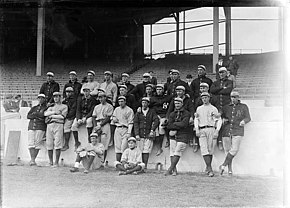
The 1913 squad, the first that went by the name "Yankees"
The history of the New York Yankees Major League Baseball (MLB) team spans more than a century. Frank J. Farrell and William Stephen Devery bought the rights to an American League (AL) club in New York City after the 1902 season. The team, which became known as the Yankees in 1913, rarely contended for the AL championship before the acquisition of outfielder Babe Ruth after the 1919 season. With Ruth in the lineup, the Yankees won their first AL title in 1921, followed by their first World Series championship in 1923. Ruth and first baseman Lou Gehrig were part of the team's Murderers' Row lineup, which led the Yankees to a then-AL record 110 wins and a Series championship in 1927 under Miller Huggins. They repeated as World Series winners in 1928, and their next title came under manager Joe McCarthy in 1932.
The Yankees won the World Series every year from 1936 to 1939 with a team that featured Gehrig and outfielder Joe DiMaggio, who recorded a record hitting streak during New York's 1941 championship season. New York set a major league record by winning five consecutive championships from 1949 to 1953, and appeared in the World Series nine times from 1955 to 1964. Mickey Mantle, Yogi Berra, and Whitey Ford were among the players fielded by the Yankees during the era. After the 1964 season, a lack of effective replacements for aging players caused the franchise to decline on the field, and the team became a money-loser for owners CBS while playing in an aging stadium. (Full article...) -
Image 5
Stanley Anthony Coveleski (born Stanislaus Kowalewski, July 13, 1889 – March 20, 1984) was an American right-handed pitcher in Major League Baseball who played for four American League (AL) teams between 1912 and 1928, primarily the Cleveland Indians. The star of the Indians pitching staff, he won over 20 games each year from the war-shortened 1918 season through 1921, leading the AL in shutouts twice and in strikeouts and earned run average (ERA) once each during his nine years with the club. The star of the 1920 World Series, he led the Indians to their first title with three complete-game victories, including a 3–0 shutout in the Game 7 finale. Traded to the Washington Senators after the 1924 season, he helped that club to its second AL pennant in a row with 20 victories against only 5 losses, including a 13-game winning streak, while again leading the league in ERA.
Coveleski followed in the footsteps of his brother Harry as a major league pitcher. But after making his debut with the Philadelphia Athletics in 1912, he was sidetracked by three more seasons in the minor leagues before joining the Indians in 1916, and won only 13 major league games before turning 27. Coveleski specialized in throwing the spitball, where the pitcher alters the ball with a foreign substance such as chewing tobacco. It was legal when his career began but prohibited in 1920, with Coveleski being one of 17 pitchers permitted to continue throwing the pitch. In 450 career games, Coveleski pitched 3,082 innings and posted a record of 215–142, with 224 complete games, 38 shutouts, and a 2.89 ERA. He set Cleveland records of 172 wins, 2,502+1⁄3 innings and 305 starts, which were later broken by Mel Harder and Willis Hudlin. He was inducted into the Baseball Hall of Fame in 1969. (Full article...) -
Image 6
Osborne Earl Smith (born December 26, 1954) is an American former professional baseball player. Nicknamed "The Wizard of Oz", Smith played shortstop for the San Diego Padres and St. Louis Cardinals in Major League Baseball, winning the National League Gold Glove Award for defensive play at shortstop for 13 consecutive seasons. A 15-time All-Star, Smith accumulated 2,460 hits and 580 stolen bases during his career, and won the National League Silver Slugger Award as the best hitter at shortstop in 1987. He was elected to the Baseball Hall of Fame in his first year of eligibility in 2002. He was also elected to the St. Louis Cardinals Hall of Fame in the inaugural class of 2014.
Smith was born in Mobile, Alabama; his family moved to Watts, Los Angeles, when he was six years old. While participating in childhood athletic activities, Smith possessed quick reflexes; he went on to play baseball at Locke High School in Los Angeles, then at California Polytechnic State University, San Luis Obispo. Drafted as an amateur player by the Padres, Smith made his major league debut in 1978. He quickly established himself as an outstanding fielder, and later became known for performing backflips on special occasions while taking his position at the beginning of a game. Smith won his first Gold Glove Award in 1980 and made his first All-Star Game appearance in 1981. (Full article...) -
Image 7
Robert William Meusel (July 19, 1896 – November 28, 1977) was an American baseball left and right fielder who played in Major League Baseball (MLB) for eleven seasons from 1920 through 1930, all but the last for the New York Yankees. He was best known as a member of the Yankees' championship teams of the 1920s, nicknamed "Murderers' Row", during which time the team won its first six American League (AL) pennants and first three World Series titles.
Meusel, noted for his strong outfield throwing arm, batted fifth behind Baseball Hall of Famers Babe Ruth and Lou Gehrig. In 1925, he became the second Yankee, after Ruth, to lead the AL in home runs (33), runs batted in (138) and extra base hits (79). Nicknamed "Long Bob" because of his 6-foot, 3 inch (1.91 m) stature, Meusel batted .313 or better in seven of his first eight seasons, finishing with a .309 career average; his 1,009 RBI during the 1920s were the fourth most by any major leaguer, and trailed only Harry Heilmann's total of 1,131 among AL right-handed hitters. Meusel ended his career in 1930 with the Cincinnati Reds. He hit for the cycle three times, and was the second of six major leaguers to accomplish this feat as many as three times during a career. (Full article...) -
Image 8
Robert William Andrew Feller (November 3, 1918 – December 15, 2010), nicknamed "the Heater from Van Meter", "Bullet Bob", and "Rapid Robert", was an American baseball pitcher who played 18 seasons in Major League Baseball (MLB) for the Cleveland Indians between 1936 and 1956. In a career spanning 570 games, Feller pitched 3,827 innings and posted a win–loss record of 266–162, with 279 complete games, 44 shutouts, and a 3.25 earned run average (ERA). His career 2,581 strikeouts were third all-time upon his retirement.
A prodigy who bypassed baseball's minor leagues, Feller made his debut with the Indians at the age of 17. His career was interrupted by four years of military service (1942–1945) as a United States Navy Chief Petty Officer aboard USS Alabama during World War II. Feller became the first pitcher to win 24 games in a season before the age of 21. He threw no-hitters in 1940, 1946, and 1951, and 12 one-hitters, both records at his retirement. He helped the Indians win a World Series title in 1948 and an American League-record 111 wins and the pennant in 1954. Feller led the American League in wins six times and in strikeouts seven times. In 1946 he recorded 348 strikeouts, the most since 1904 and then believed to be a record. (Full article...) -
Image 9
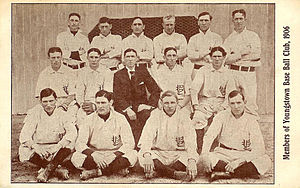
Youngstown Ohio Works (1906), with pitcher Roy Castleton seated in second row, second from left
The Youngstown Ohio Works baseball team was a minor league club that was known for winning the premier championship of the Ohio–Pennsylvania League in 1905, and for launching the professional career of pitcher Roy Castleton a year later. A training ground for several players and officials who later established careers in Major League Baseball, the team proved a formidable regional competitor and also won the 1906 league championship.
During its brief span of activity, the Ohio Works team faced challenges that reflected common difficulties within the Ohio–Pennsylvania League, including weak financial support for teams. Following a dispute over funding, the team's owners sold the club to outside investors, just a few months before the opening of the 1907 season. (Full article...) -
Image 10
Stephen Crane (November 1, 1871 – June 5, 1900) was an American poet, novelist, and short story writer. Prolific throughout his short life, he wrote notable works in the Realist tradition as well as early examples of American Naturalism and Impressionism. He is recognized by modern critics as one of the most innovative writers of his generation.
The ninth surviving child of Methodist parents, Crane began writing at the age of four and had several articles published by 16. Having little interest in university studies though he was active in a fraternity, he left Syracuse University in 1891 to work as a reporter and writer. Crane's first novel was the 1893 Bowery tale Maggie: A Girl of the Streets, generally considered by critics to be the first work of American literary Naturalism. He won international acclaim for his Civil War novel The Red Badge of Courage (1895), considered a masterpiece by different critics and writers. (Full article...) -
Image 11

WSNS-TV (channel 44) is a television station in Chicago, Illinois, United States, serving as the local outlet for the Spanish-language network Telemundo. It is owned and operated by NBCUniversal's Telemundo Station Group alongside NBC outlet WMAQ-TV (channel 5). The two stations share studios at the NBC Tower on North Columbus Drive in the city's Streeterville neighborhood and broadcast from the same transmitter atop the Willis Tower in the Chicago Loop.
WSNS-TV began broadcasting in 1970. Originally specializing in the automated display of news headlines, it evolved into Chicago's third full-fledged independent station, carrying movies, local sports, and other specialty programming. This continued until 1980, when WSNS became the Chicago-area station for ON TV, an over-the-air subscription television (STV) service owned by Oak Industries, which took a minority ownership stake in the station. While ON TV was successful in Chicago and the subscription system became the second-largest in the country by total subscribers, the rise of cable television precipitated the end of the business in 1985, with WSNS-TV as the last ON TV station standing. (Full article...) -
Image 12
Harmon Clayton Killebrew Jr. (/ˈkɪlɪbruː/; June 29, 1936 – May 17, 2011), nicknamed "the Killer" and "Hammerin' Harmon", was an American professional baseball first baseman, third baseman, and left fielder. He spent most of his 22-year career in Major League Baseball (MLB) with the Minnesota Twins. A prolific power hitter, Killebrew had the fifth-most home runs in major league history at the time of his retirement. He was second only to Babe Ruth in American League (AL) home runs, and was the AL career leader in home runs by a right-handed batter. Killebrew was inducted into the National Baseball Hall of Fame in 1984.
Killebrew was 5-foot-11-inch (180 cm) tall and 213 pounds (97 kg). His compact swing generated tremendous power and made him one of the most feared power hitters of the 1960s, when he hit at least 40 home runs per season eight times. In total Killebrew led the league six times in home runs and three times in RBIs, and was named to 13 All-Star teams. In 1965, he played in the World Series with the Twins, who lost to the Los Angeles Dodgers. His finest season was 1969, when he hit 49 home runs, recorded 140 RBIs and won the AL Most Valuable Player Award while helping lead the Twins to the AL West pennant. (Full article...) -
Image 13Ross with the Montreal Wanderers, circa 1907–18
Arthur Howey Ross (January 13, 1885 – August 5, 1964) was a Canadian professional ice hockey player and executive from 1905 until 1954. Regarded as one of the best defenders of his era by his peers, he was one of the first to skate with the puck up the ice rather than pass it to a forward. He was on Stanley Cup championship teams twice in a playing career that lasted thirteen seasons; in January 1907 with the Kenora Thistles and 1908 with the Montreal Wanderers. Like other players of the time, Ross played for several different teams and leagues, and is noted for his time with the Wanderers while they were members of the National Hockey Association (NHA) and its successor, the National Hockey League (NHL). In 1911, he led one of the first organized player strikes over increased pay. When the Wanderers' home arena burned down in January 1918, the team ceased operations and Ross retired as a player.
After several years as an on-ice official, he was named head coach of the Hamilton Tigers for one season. When the Boston Bruins were formed in 1924, Ross was hired as the first coach and general manager of the team. He later coached the team on three separate occasions until 1945, and stayed as general manager until his retirement in 1954. Ross helped the Bruins finish first place in the league ten times and win the Stanley Cup three times; Ross personally coached the team to two of those victories. After being hired by the Bruins, Ross, along with his wife and two sons, moved to a suburb of Boston, and he became an American citizen in 1938. He died near Boston in 1964. (Full article...) -
Image 14
Michael Jeffrey Jordan (born February 17, 1963), also known by his initials MJ, is an American businessman and former professional basketball player. He played 15 seasons in the National Basketball Association (NBA) between 1984 and 2003, winning six NBA championships with the Chicago Bulls. He was integral in popularizing basketball and the NBA around the world in the 1980s and 1990s, becoming a global cultural icon. His profile on the NBA website states, "By acclamation, Michael Jordan is the greatest basketball player of all time."
Jordan played college basketball with the North Carolina Tar Heels. As a freshman, he was a member of the Tar Heels' national championship team in 1982. Jordan joined the Bulls in 1984 as the third overall draft pick and quickly emerged as a league star, entertaining crowds with his prolific scoring while gaining a reputation as one of the best defensive players. His leaping ability, demonstrated by performing slam dunks from the free-throw line in Slam Dunk Contests, earned him the nicknames "Air Jordan" and "His Airness". Jordan won his first NBA title with the Bulls in 1991 and followed that achievement with titles in 1992 and 1993, securing a three-peat. Citing physical and mental exhaustion from basketball and superstardom, Jordan abruptly retired from basketball before the 1993–94 NBA season to play Minor League Baseball in the Chicago White Sox organization. He returned to the Bulls in March 1995 and led them to three more championships in 1996, 1997, and 1998, as well as a then-record 72 regular season wins in the 1995–96 NBA season. Jordan retired for the second time in January 1999, returning for two more NBA seasons from 2001 to 2003 as a member of the Washington Wizards. He was selected to play for the United States national team during his college and NBA careers, winning four gold medals—at the 1983 Pan American Games, 1984 Summer Olympics, 1992 Tournament of the Americas and 1992 Summer Olympics—while also being undefeated. (Full article...) -
Image 15
William Harold Ponsford MBE (19 October 1900 – 6 April 1991) was an Australian cricketer. Usually playing as an opening batsman, he formed a successful and long-lived partnership opening the batting for Victoria and Australia with Bill Woodfull, his friend and state and national captain. Ponsford is the only player to twice break the world record for the highest individual score in first-class cricket; Ponsford and Brian Lara are the only cricketers to twice score 400 runs in an innings. Ponsford holds the Australian record for a partnership in Test cricket, set in 1934 in combination with Don Bradman (451 for 2nd wicket)—the man who broke many of Ponsford's other individual records. In fact, he along with Bradman set the record for the highest partnership ever for any wicket in Test cricket history when playing on away soil (451 runs for the second wicket)
Despite being heavily built, Ponsford was quick on his feet and renowned as one of the finest ever players of spin bowling. His bat, much heavier than the norm and nicknamed "Big Bertha", allowed him to drive powerfully and he possessed a strong cut shot. However, critics questioned his ability against fast bowling, and the hostile short-pitched English bowling in the Bodyline series of 1932–33 was a contributing factor in his early retirement from cricket a year and a half later. Ponsford also represented his state and country in baseball, and credited the sport with improving his cricketing skills. (Full article...)
General images - load new batch
-
Image 1Alexander Cartwright, father of modern baseball (from History of baseball)
-
Image 2Diagram of a baseball field Diamond may refer to the square area defined by the four bases or to the entire playing field. The dimensions given are for professional and professional-style games. Children often play on smaller fields. (from Baseball)
-
Image 4Defensive positions on a baseball field, with abbreviations and scorekeeper's position numbers (not uniform numbers) (from Baseball)
-
Image 5The strike zone determines the result of most pitches, and varies in vertical length for each batter. (from Baseball)
-
Image 6In May 2010, the Philadelphia Phillies' Roy Halladay pitched the 20th major league perfect game. That October, he pitched only the second no-hitter in MLB postseason history. (from History of baseball)
-
Image 7Baserunners generally stand a short distance away from their base between pitches, preparing themselves to either go back or steal the next base. (from Baseball rules)
-
Image 9Sadaharu Oh managing the Japan national team in the 2006 World Baseball Classic. Playing for the Central League's Yomiuri Giants (1959–80), Oh set the professional world record for home runs with 868. (from History of baseball)
-
Image 10Pitchers are generally substituted during mound visits (team gatherings at the pitcher's mound). (from Baseball rules)
-
Image 11An Afghan girl playing baseball in August 2002 (from Baseball)
-
Image 12Cy Young—the holder of many major league career marks, including wins and innings pitched, as well as losses—in 1908. MLB's annual awards for the best pitcher in each league are named for Young. (from Baseball)
-
Image 16The NL champion New York Giants baseball team, 1913. Fred Merkle, sixth in line, had committed a baserunning gaffe in a crucial 1908 game that became famous as Merkle's Boner. (from History of baseball)
-
Image 17Japanese-Americans spectating a World War II-era game while in an internment camp. America's ties to immigrants and to Japan have been deeply shaped by a shared baseball heritage. (from History of baseball)
-
Image 18Baseball games sometimes end in a walk-off home run, with the batting team usually gathering at home plate to celebrate the scoring of the winning run(s). (from Baseball rules)
-
Image 19A batter follows through after swinging at a pitched ball. (from Baseball rules)
-
Image 20A New York Yankees batter (Andruw Jones) and a Boston Red Sox catcher at Fenway Park (from Baseball)
-
Image 21A runner sliding into home plate and scoring. (from Baseball)
-
Image 22A pitcher handing off the ball after being taken out of the game during a mound meeting. (from Baseball)
-
Image 23The standard fielding positions (from Baseball rules)
-
Image 24Jackie Robinson in 1945, with the era's Kansas City Royals, a barnstorming squad associated with the Negro American League's Kansas City Monarchs (from Baseball)
-
Image 25The strike zone, which determines the outcome of most pitches, varies in vertical length depending on the batter's typical height while swinging. (from Baseball rules)
-
Image 26Sadaharu Oh managing the Japan national team in the 2006 World Baseball Classic. Playing for the Central League's Yomiuri Giants (1959–80), Oh set the professional world record for home runs. (from Baseball)
-
Image 27Jackie Robinson in 1945, with the era's Kansas City Royals, a barnstorming squad associated with the Negro American League's Kansas City Monarchs (from History of baseball)
-
Image 29Fenway Park, home of the Boston Red Sox. The Green Monster is visible beyond the playing field on the left. (from Baseball)
-
Image 30The American Tobacco Company's line of baseball cards featured shortstop Honus Wagner of the Pittsburgh Pirates from 1909 to 1911. In 2007, the card shown here sold for $2.8 million. (from Baseball)
-
Image 31Cover of Official Base Ball Rules, 1921 edition, used by the American League and National League (from Baseball rules)
-
Image 32A game from the Cantigas de Santa Maria, c. 1280, involving tossing a ball, hitting it with a stick and competing with others to catch it (from History of baseball)
-
Image 341906 World Series, infielders playing "in" for the expected bunt and the possible play at the plate with the bases loaded (from Baseball rules)
-
Image 37Pesäpallo, a Finnish variation of baseball, was invented by Lauri "Tahko" Pihkala in the 1920s, and after that, it has changed with the times and grown in popularity. Picture of Pesäpallo match in 1958 in Jyväskylä, Finland. (from Baseball)
-
Image 38A first baseman receives a pickoff throw, as the runner dives back to first base. (from Baseball)
-
Image 39Rickey Henderson—the major leagues' all-time leader in runs and stolen bases—stealing third base in a 1988 game (from Baseball)
-
Image 41The typical motion of a right-handed pitcher (from Baseball rules)
-
Image 42By the 1860s Civil War, baseball (bottom) had overtaken its fellow bat-and-ball sport cricket (top) in popularity within the United States. (from History of baseball)
-
Image 43A well-worn baseball (from Baseball)
-
Image 442013 World Baseball Classic championship match between the Dominican Republic and Puerto Rico, March 20, 2013 (from Baseball)
-
Image 45Pick-off attempt on runner (in red) at first base (from Baseball rules)
 Good articles - load new batch
Good articles - load new batch
-
Image 1
Walter William Pierce (April 2, 1927 – July 31, 2015) was an American starting pitcher in Major League Baseball between 1945 and 1964 who played most of his career for the Chicago White Sox. He was the team's star pitcher in the decade from 1952 to 1961, when they posted the third best record in the major leagues, and received the Sporting News Pitcher of the Year Award for the American League (AL) in 1956 and 1957 after being runner-up in both 1953 and 1955. A seven-time All-Star, he led the American League (AL) in complete games three times despite his slight build, and in wins, earned run average (ERA) and strikeouts once each. He pitched four one-hitters and seven two-hitters in his career, and on June 27, 1958 came within one batter of becoming the first left-hander in 78 years to throw a perfect game.
He was one of the principal figures in Chicago's fierce rivalry with the New York Yankees; particularly notable were his matchups with Whitey Ford, with the two left-handers opposing one another as starters 14 times from 1955 to 1960. Pierce's record suffered from pitching so much against New York – who he faced more often than any other team – when the Yankees dynasty was at its peak; but although his career record against New York was only 25–37, that was still slightly better than the 27–41 mark compiled by National League (NL) championship teams over 11 World Series against the Yankees during the same period. (Full article...) -
Image 2
George Edward "Duffy" Lewis (April 18, 1888 – June 17, 1979) was an American professional baseball left fielder who played in Major League Baseball (MLB) for the Boston Red Sox, the New York Yankees, and the Washington Senators from 1910 to 1921.
Lewis attended Saint Mary's College of California. He made his MLB debut with the Red Sox in 1910, where he formed the Golden Outfield with Tris Speaker and Harry Hooper. He won three World Series championships with Boston (1912, 1915, and 1916). The Red Sox traded Lewis to the Yankees, where he played in 1919 and 1920, before they traded him to the Senators before the 1921 season. He continued to play and manage in the minor leagues until 1929. (Full article...) -
Image 3
Carlos Joaquín Ruiz (born January 22, 1979), nicknamed "Chooch", is a Panamanian former professional baseball catcher. He played in Major League Baseball (MLB) for the Philadelphia Phillies, Los Angeles Dodgers, and Seattle Mariners. Ruiz stands 5 ft 10 in (1.78 m) tall, and weighs 215 pounds (98 kg). He bats and throws right-handed.
As a seven-year-old, Ruiz resolved to play in the big leagues after both his father and grandmother died within two weeks of each other. He made his way through the Phillies farm system from 1998 until 2006, playing at each level of Minor League Baseball (MiLB). Ruiz soon fulfilled his childhood dream, making his MLB debut with the 2006 Phillies. He battled adversity in his progression through the system, including feeling homesick, a position change, and the language barrier (he spoke Spanish, while most teammates and team officials spoke English). (Full article...) -
Image 4
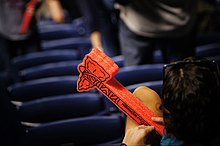
The Atlanta Braves encouraged fans to gesture with the tomahawk chop, distributing foam tomahawks at games and other events.
Since the 1960s, the issue of Native American and First Nations names and images being used by sports teams as mascots has been the subject of increasing public controversy in the United States and Canada. This has been a period of rising Indigenous civil rights movements, and Native Americans and their supporters object to the use of images and names in a manner and context they consider derogatory. They have conducted numerous protests and tried to educate the public on this issue.
In response since the 1970s, an increasing number of secondary schools have retired such Native American names and mascots. Changes accelerated in 2020, following public awareness of institutional racism prompted by nationally covered cases of police misconduct. National attention was focused on the prominent use of names and images by professional franchises including the Washington Commanders (Redskins until July 2020) and the Cleveland Guardians (Indians until November 2021). In Canada, the Edmonton Eskimos became the Edmonton Elks in 2021. Each such change at the professional level has been followed by changes of school teams; for instance, 29 changed their names between August and December 2020. A National Congress of American Indians (NCAI) database tracks some 1,900 K-12 schools in 970 school districts with Native “themed” school mascots. (Full article...) -
Image 5Jonathan Brian Weber (born January 20, 1978, in Lakewood, California) is an American former professional baseball player. An outfielder, Weber batted and threw left-handed. Considered a journeyman throughout his career, Weber played professionally in minor and independent league baseball from 1999 to 2015. Weber also competed for the United States national baseball team, winning the gold medal at the 2009 Baseball World Cup. (Full article...)
-
Image 6
Vernon Edgell Bickford (August 17, 1920 – May 6, 1960) was an American professional baseball player. A right-handed starting pitcher, he played six seasons in Major League Baseball (MLB) for the Boston/Milwaukee Braves from 1948 to 1953 in the National League, and one game for the Baltimore Orioles of the American League in 1954.
Bickford was born in Kentucky but raised in West Virginia. He began his professional career in 1939 and, after serving in World War II, made the majors in 1949. Acquired by the Braves organization due to a flip of a coin, Bickford became one of the most promising National League pitchers during his playing career, earning All-Star honors in 1949 and leading the National League in complete games in 1950. However his career was soon shorted by multiple arm injuries, and he was out of baseball by 1955. After working an assortment of jobs, he was diagnosed with stomach cancer in 1960 and died after a three-month illness. (Full article...) -
Image 7
William Charles Virdon (June 9, 1931 – November 23, 2021) was an American professional baseball outfielder, manager, and coach in Major League Baseball (MLB). Virdon played in MLB for the St. Louis Cardinals and Pittsburgh Pirates from 1955 through 1965 and in 1968. He served as a coach for the Pirates and Houston Astros, and managed the Pirates, Astros, New York Yankees, and Montreal Expos.
After playing in the minors for the Yankees organization, Virdon was traded to the Cardinals, and he made his MLB debut in 1955. That year, Virdon won the National League Rookie of the Year Award. He slumped at the beginning of the 1956 season, and was traded to the Pirates, where he spent the remainder of his playing career. A premier defensive outfielder during his playing days as a center fielder for the Cardinals and Pirates, Virdon led a strong defensive team to the 1960 World Series championship. In 1962, Virdon won a Gold Glove Award. Following the 1965 season, he retired due to his desire to become a manager. (Full article...) -
Image 8Greene with the Louisville Bats in 2021
Christian Hunter Greene (born August 6, 1999) is an American professional baseball pitcher for the Cincinnati Reds of Major League Baseball (MLB). The Reds selected him second overall in the 2017 MLB Draft.
Born in Los Angeles, California, Greene learned how to pitch at the Major League Baseball Urban Youth Academy in Compton. His fastball velocity was already 93 mph (150 km/h) during his first year at Notre Dame High School, and by the time he graduated in 2017, it was up to 102 mph (164 km/h). The Reds drafted Greene out of high school, and he joined their farm system rather than playing college baseball. Greene suffered an ulnar collateral ligament injury partway through the 2018 season and underwent Tommy John surgery the following year. The COVID-19 pandemic kept him from pitching for another year, but once he returned in 2021, he quickly rose through the minor leagues. (Full article...) -
Image 9
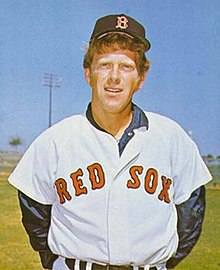
Lewis Bernard Krausse Jr. (April 25, 1943 – February 16, 2021) was an American professional baseball pitcher who played 12 seasons in Major League Baseball (MLB). He played for the Kansas City / Oakland Athletics, Milwaukee Brewers, Boston Red Sox, St. Louis Cardinals, and Atlanta Braves from 1961 to 1974. He batted and threw right-handed and served primarily as a starting pitcher. Once a highly-touted prospect, he had to overcome arm trouble early in his career and spent most of his career with teams that offered low run support.
Krausse was the son of a former Philadelphia Athletics pitcher who remained with the organization as a scout after it moved to Kansas City. Signed to a $125,000 contract following his graduation from high school in 1961, he pitched a shutout in his first MLB start on June 16 of that year. Arm trouble threatened his career after that, and it was not until 1966 that he became a regular in the major leagues. He won 14 games with the Athletics that year, the most he would ever win in a season. In 1967, he had a bitter disagreement with team owner Charlie Finley concerning the pitcher's activities on a team flight; the rift led to the firing of manager Alvin Dark and the release of first baseman Ken Harrelson. In 1968, he started the first game at the Oakland-Alameda County Coliseum after the Athletics moved to California. Two years later, he started the first game in Milwaukee Brewers history, pitching the team's first shutout in the same year. He pitched for Boston in 1972, St. Louis in 1973, and Atlanta in 1974, then spent a year in the minor leagues before retiring. Following his baseball career, Krausse and partners started a metal business in the Kansas City area, which Krausse remained involved in from 1983 to 1997. (Full article...) -
Image 10
Nathan John "Nate" Schierholtz (born February 15, 1984) is an American former professional baseball right fielder. He played in Major League Baseball (MLB) for the San Francisco Giants (2007–2012), Philadelphia Phillies (2012), Chicago Cubs (2013–2014), and Washington Nationals (2014). He also played in Nippon Professional Baseball (NPB) for Hiroshima Toyo Carp (2015). (Full article...) -
Image 11
Clifford Michael Brumbaugh (born April 21, 1974) is an American former professional baseball player. From Wilmington, Delaware, he played college baseball for the Delaware Fightin' Blue Hens where he was a two-time All-American and the North Atlantic Conference (NAC) Player of the Year. Drafted by the Texas Rangers of Major League Baseball (MLB) in 1995, he played in the minor leagues until being called up to the majors in 2001.
After playing seven games for the Rangers, Brumbaugh was waived and claimed by the Colorado Rockies, playing 14 games with the Rockies that season. After spending 2002 and part of 2003 in the minor leagues, he requested a release and joined the Hyundai Unicorns of the KBO League mid-season. He became a top player for the Unicorns and helped them win consecutive Korean Series titles, while Brumbaugh won the Golden Glove Award and was league batting champion in 2004. (Full article...) -
Image 12
John Claiborn Mayberry Jr. (born December 21, 1983), is an American former professional baseball outfielder, who played in the Major League Baseball (MLB) for the Philadelphia Phillies, Toronto Blue Jays, and New York Mets.
Mayberry played high school baseball in Kansas City, and USA Today named him a first-team 2002 All-USA player. In the 2002 Major League Baseball draft, the Seattle Mariners drafted him out of high school in the first round (28th overall). Mayberry chose not to sign, however, instead attending Stanford University, and also playing for the United States national baseball team at the World University Baseball Championship in 2004, winning a gold medal. After he played three years at Stanford, Mayberry was drafted again. The Texas Rangers selected him in the first round (19th overall) of the 2005 Major League Baseball draft. (Full article...) -
Image 13
Cindy Lou McCain (née Hensley; born May 20, 1954) is an American diplomat, businesswoman, and humanitarian who is the executive director of the World Food Programme. McCain previously served as U.S. Ambassador to the United Nations Agencies for Food and Agriculture from 2021 to 2023. She is the widow of U.S. Senator John McCain from Arizona, who was the 2008 Republican presidential nominee.
McCain was born and raised in Phoenix, Arizona, and is a daughter of wealthy beer distributor Jim Hensley. After receiving bachelor's and master's degrees from the University of Southern California, she became a special education teacher. She married John McCain in 1980, and the couple moved to Arizona in 1981, where her husband was elected to the United States Congress the following year and reelected five more times. The couple had three children together, in addition to adopting another. From 1988 to 1995, she founded and operated a nonprofit organization, the American Voluntary Medical Team, which organized trips by medical personnel to disaster-stricken or war-torn third-world areas. (Full article...) -
Image 14
Colbert Michael Hamels (born December 27, 1983), nicknamed "Hollywood", is an American former professional baseball pitcher. He played in Major League Baseball (MLB) for the Philadelphia Phillies (2006–2015), Texas Rangers (2015–2018), Chicago Cubs (2018–2019), and Atlanta Braves (2020).
Originally from San Diego, California, Hamels excelled at Rancho Bernardo High School both academically and athletically. The Phillies drafted Hamels out of high school, in the first round (17th overall) of the 2002 MLB Draft, and he began playing in the Phillies’ minor league system. Numerous issues, including an injury sustained in a bar fight, among other injuries, occurred during Hamels’ first few minor league seasons. When he reached the Triple-A level, he was the top pitcher in the Phillies' minor league system in 2006. (Full article...) -
Image 15Pederson with the Los Angeles Dodgers in 2017
Joc Russell Pederson (/ˈpiːdərsən/ PEE-dər-sən; born April 21, 1992) is an American professional baseball outfielder who is a free agent. He has played in Major League Baseball (MLB) for the Los Angeles Dodgers, Chicago Cubs, Atlanta Braves, San Francisco Giants, and Arizona Diamondbacks. He is a two-time World Series champion and a two-time All-Star. Internationally, Pederson represents the Israel national baseball team in international competition.
The son of former MLB player Stu Pederson, Joc was drafted by the Dodgers in the 11th round of the 2010 MLB draft out of Palo Alto High School. By virtue of his Jewish heritage, he played for the Israel national baseball team in the 2013 World Baseball Classic. He was ranked the Dodgers' top prospect by Baseball America after the 2013 season. In 2014, he was named the Pacific Coast League (PCL) Most Valuable Player after hitting 30 home runs and stealing 30 bases, and he made his major league debut that September. (Full article...)
Did you know (auto-generated) - load new batch

- ... that after he retired from professional baseball, Paul Hinrichs became a Lutheran minister?
- ... that the 1999 video game Interplay Sports Baseball Edition 2000 used a public-address announcer while its rivals were switching to two commentators as featured on real MLB game broadcasts?
- ... that in the 1932 baseball game in which pitcher Eddie Rommel won his last game, he pitched 17 innings in relief, an American League record?
- ... that Amanda Asay was the longest-serving member of the Canadian women's baseball team when she died at 33, having played on the team for sixteen years?
- ... that Benny Lefebvre had three sons who signed professional baseball contracts and four brothers who played football?
- ... that Park "Saebyeolbe" Jong-ryeol was the first esports player to throw a Major League Baseball opening pitch?
- ... that Billy Raimondi declined opportunities to play in Major League Baseball?
- ... that the injuries Anthony W. Case suffered in a school shooting led him to give up baseball and turn to astrophysics as a career?
Quotes
| It ain't over 'til it's over.
— Yogi Berra, In July 1973, when the New York Mets trailed the Chicago Cubs by 9½ games in the National League East; the Mets won the division title on the final day of the season.
|
 Featured lists - load new batch
Featured lists - load new batch
-
Image 1

Mariano Rivera has the most career saves in Major League Baseball history with 652.
In Major League Baseball (MLB), the 300 save club is the group of pitchers who have recorded 300 or more regular-season saves in their careers. Most commonly a relief pitcher ("reliever" or "closer") earns a save by being the final pitcher of a game in which his team is winning by three or fewer runs and pitching at least one inning without losing the lead. The final pitcher of a game can earn a save by getting at least one batter out to end the game with the tying run on base, at bat, or on deck, or by pitching the last three innings without relinquishing the lead, regardless of score.
The statistic was created by Jerome Holtzman in 1959 to "measure the effectiveness of relief pitchers" and was adopted as an official statistic by MLB in 1969. The save has been retroactively measured for past pitchers where applicable. Hoyt Wilhelm retired in 1972 and recorded just 31 saves from 1969 onwards, for example, but holds 228 total career saves.
Mariano Rivera holds the MLB save record with 652. Only Rivera and Trevor Hoffman have exceeded 500 or 600 saves, and Hoffman was the first to achieve either. Only eight pitchers have recorded 400 or more saves: Rivera, Hoffman, Lee Smith, Kenley Jansen, Craig Kimbrel, Francisco Rodríguez, John Franco, and Billy Wagner. (Full article...) -
Image 2

Jewish players have played in Major League Baseball since the league came into existence in the late 19th century, and have a long and storied history within the game. There have been 190 players who identified as Jewish during their Major League career, including players who converted during or before their careers, and players who have or had at least one Jewish parent, and identified as Jewish by virtue of their parentage.
In the early years, Jewish baseball players faced constant antisemitic heckles from opponents and fans, with many hiding their heritage to avoid discrimination in the league. Despite this, a number of Jewish players overcame such abuse and went on to become stars. Two such players, Hank Greenberg and Sandy Koufax, were both elected to the Baseball Hall of Fame and are widely considered to be amongst the most important and iconic players in baseball and American history. The sport played a large part in the assimilation of American Jews into American society at a time of rampant antisemitism, and remains a very important part in Jewish American culture today. (Full article...) -
Image 3

Justin Upton, the first overall selection in 2005, was named to the 2009 All-Star Team.
The Arizona Diamondbacks are a Major League Baseball franchise based in Phoenix, Arizona. The Diamondbacks compete in the National League West division. Officially known as the "First-Year Player Draft", the Rule 4 Draft is Major League Baseball's primary mechanism for assigning amateur baseball players from high schools, colleges, and other amateur baseball clubs to its teams. The draft order is determined based on the previous season's standings, with the team possessing the worst record receiving the first pick. In addition, teams which lost free agents in the previous off-season may be awarded compensatory or supplementary picks. Since the franchise first participated in the draft in 1996, the Diamondbacks have selected 28 players in the first round. The First-Year Player Draft is unrelated to the 1997 expansion draft in which the Diamondbacks filled their roster.
Of the 28 players picked in the first round by the Diamondbacks, 15 have been pitchers, the most of any position; 11 of these have been right-handed, while 4 have been left-handed. Five players taken in the first round have been shortstops; additionally, two players have been selected at each of first base, third base, catcher, and the outfield. No second baseman has been selected in the first round by the Diamondbacks. The Diamondbacks have drafted 16 players out of college, and 10 out of high school. Arizona has drafted seven players out of high schools or colleges in the state of California, with two being taken from each of Florida, Georgia, and their home state of Arizona. (Full article...) -
Image 4

Barry Bonds has won 12 Silver Slugger Awards, the most of any player at any position.
The Silver Slugger Award is awarded annually to the best offensive player at each position in both the American League (AL) and the National League (NL), as determined by the coaches and managers of Major League Baseball (MLB). These voters consider several offensive categories in selecting the winners, including batting average, slugging percentage, and on-base percentage, in addition to "coaches' and managers' general impressions of a player's overall offensive value". Managers and coaches are not permitted to vote for players on their own team. The Silver Slugger was first awarded in 1980 and is given by Hillerich & Bradsby, the manufacturer of Louisville Slugger bats. The award is a bat-shaped trophy, 3 feet (91 cm) tall, engraved with the names of each of the winners from the league and plated with sterling silver.
As with the Rawlings Gold Glove Award, the prize is presented to outfielders irrespective of their specific position. This means that it is possible for three left fielders, or any other combination of outfielders, to win the award in the same year, rather than one left fielder, one center fielder, and one right fielder. It is also possible for outfield teammates to win the award in the same season, which has happened eight times since 1980. (Full article...) -
Image 5

The 1980 Sounds set a team-best 97–46 (.678) record playing as the Double-A affiliate of the New York Yankees in the Southern League.
The Nashville Sounds Minor League Baseball team has played in Nashville, Tennessee, for 47 years since being established in 1978. As of the completion of the 2024 season, the club has played 6,566 regular-season games and compiled a win–loss record of 3,398–3,168–2 (.518). They have appeared in the postseason on 16 occasions in which they have a record of 49–44 (.527) in 93 games. Combining all 6,659 regular-season and postseason games, Nashville has an all-time record of 3,447–3,212–2 (.518).
Created as an expansion team of the Double-A Southern League (SL) in 1978, the Sounds played in this league through 1984. At the Double-A classification, Nashville was affiliated with Major League Baseball's Cincinnati Reds (1978–1979) and New York Yankees (1980–1984). The Sounds moved up to Triple-A in 1985 as members of the American Association (AA) before joining the Pacific Coast League (PCL) in 1998. They were placed in the Triple-A East (AAAE) in 2021, but this became the International League (IL) in 2022. At this level, they have been affiliates of the Detroit Tigers (1985–1986), Cincinnati Reds (1987–1992), Chicago White Sox (1993–1997), Pittsburgh Pirates (1998–2004), Milwaukee Brewers (2005–2014), Oakland Athletics (2015–2018), and Texas Rangers (2019–2020). The Sounds reaffiliated with the Milwaukee Brewers in 2021. (Full article...) -
Image 6First-round selections Ken Griffey Jr. (top left), Mike Harkey (top right), Jack McDowell (bottom left), and Mike Remlinger (bottom right).
The 1987 Major League Baseball draft is the process by which Major League Baseball (MLB) teams select athletes to play for their organization. High school seniors, college juniors and seniors, and anyone who had never played under a professional contract were considered eligible for the draft. The 1987 MLB Draft took place as a conference call to the Commissioner of Baseball's office in New York from June 2–4. As opposed to the National Football League Draft which appeared on ESPN, no network aired the MLB Draft.
The American League (AL) and the National League (NL) alternated picks throughout the first round; because an NL team drafted first in the 1986 MLB Draft, an AL team had the first selection in 1987. Having finished 67–95 in 1986, the Seattle Mariners had the worst record in the AL and thus obtained the first overall selection. The second selection went to the Pittsburgh Pirates, who had the worst record in the NL. (Full article...) -
Image 7

Eddie Guardado, a pitcher for the 1993 Xpress, was called up after 10 starts to make his MLB debut with the Minnesota Twins on June 13, 1993.
The Nashville Xpress Minor League Baseball team played two seasons in Nashville, Tennessee, from 1993 to 1994 as the Double-A affiliate of the Minnesota Twins. In those seasons, a total of 60 players competed in at least one game for the Xpress. The 1993 roster included a total of 35 players, while 38 played for the team in 1994. There were 13 players who were members of the team in both seasons. Of the 60 all-time Xpress players, 22 also played in at least one game for a Major League Baseball (MLB) team during their careers.
After the 1992 baseball season, Charlotte, North Carolina, home of the Double-A Southern League's Charlotte Knights, acquired a Triple-A expansion team in the International League, leaving the Southern League franchise in need of a new home. Larry Schmittou, president of the Triple-A Nashville Sounds, offered Herschel Greer Stadium as a temporary home for the displaced team until owner George Shinn could find a permanent home for his club. Upon the league's approval, the franchise relocated to Nashville and became the Nashville Xpress. In order to accommodate two teams at Greer, the Xpress' games were scheduled for during the Sounds' road trips. (Full article...) -
Image 8

The Philadelphia Phillies won their second consecutive pennant in 2009 and lost to the San Francisco Giants in the 2010 NLCS.
The National League pennant winner of a given Major League Baseball season is the team that wins the championship—the pennant—of MLB's National League (NL). This team receives the Warren C. Giles Trophy and the right to play in the World Series against the champion of the American League (AL). The current NL pennant winners are the Los Angeles Dodgers, who beat out the New York Mets to win the NL pennant in October 2024.
The trophy is named for Warren Giles, the league president from 1951 to 1969, and is presented immediately after each NL Championship Series (NLCS) by Warren's son Bill Giles, the honorary league president and former owner of the Philadelphia Phillies. (Full article...) -
Image 9

Josh Beckett (1999) won a World Series ring with the Marlins in 2003 and then with the Boston Red Sox in 2007.
The Miami Marlins are a Major League Baseball (MLB) franchise based in Miami, Florida. They play in the National League East division. Since the franchise was established in 1993 as the Florida Marlins, the Marlins have selected 35 players in the first round. Officially known as the "First-Year Player Draft", the Rule 4 Draft is MLB's primary mechanism for assigning players from high schools, colleges, and other amateur clubs to its franchises. The draft order is determined based on the previous season's standings, with the team possessing the worst record receiving the first pick. In addition, teams which lost free agents in the previous off-season may be awarded compensatory or supplementary picks. The First-Year Player Draft is unrelated to the 1992 expansion draft in which the Marlins filled their roster.
Of the 35 players picked in the first round by the Marlins, 20 have been pitchers, the most of any position; 11 of these were right-handed, while nine were left-handed. Six outfielders were selected and three players each were taken at first base, third base, and catcher. The Marlins have also drafted one shortstop in the first round, though they have never taken a second baseman. Seven of the players came from high schools or universities in the state of California; Florida and Texas schools each produced four players; and Louisiana schools produced three. (Full article...) -
Image 10
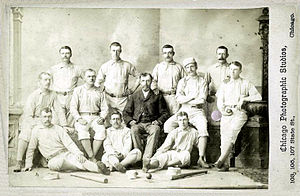
1882 Providence Grays
The Providence Grays were a Major League Baseball franchise based in Providence, Rhode Island from 1878 to 1885. During the team's eight seasons in the National League (NL), which then comprised eight teams, they finished third place or higher in the final standings seven times, and won the league championship in both 1879 and 1884. Providence played their home games at the Messer Street Grounds, which was located in the Olneyville neighborhood of Providence. The Grays were officially organized on January 16, 1878 by Benjamin Douglas, who became the team's general manager. Henry Root was hired as the team president‚ and Tom Carey was initially hired to be the on-field captain, whose duties were similar to the modern-day manager. On January 21, 1878, Providence applied for membership in the NL, and was officially approved on February 6. On April 10, Root took over ownership of the team, fired Douglas for incompetence and insubordination, and hired Tom York to replace Carey as captain.
Providence was successful in signing several star players for their inaugural season: Paul Hines had played the previous four seasons with the Chicago White Stockings; Tom Carey was signed after the Hartford Dark Blues folded; Doug Allison was the catcher for the 1869 Cincinnati Red Stockings, who had an 84-game winning streak from 1869 to 1870; and John Montgomery Ward, who was playing his first season in the major leagues. Ward had a win–loss record of 22–13 and Hines led the league in home runs, runs batted in (RBIs), and batting average as the Grays finished in third place among the six teams in the NL for the 1878 season, with a record of 33 wins, 27 losses, and 2 ties. The Grays won the NL championship in 1879, placing first among the league's eight teams with Ward winning 47 games as their starting pitcher, and the leadership of George Wright, who played second base and also managed. The team had a strong hitting line-up with Hines' league leading .357 batting average, as well as new additions Jim O'Rourke and Joe Start, who both had batting averages over .300. William Edward White, a Brown University player who played one game for the Grays on June 21, 1879, may have been the first African-American to play at the major league level; according to Peter Morris of the Society for American Baseball Research, the evidence for White is strong, but not conclusive. If this claim is true, then White pre-dated both Moses Fleetwood Walker and his brother Weldy Walker, who both played for the 1884 Toledo Blue Stockings of the American Association (AA). In 1880, the Grays finished in second place among the eight NL teams, with Ward winning 39 games. On June 17 of that year, Ward pitched the second perfect game in major league history. (Full article...) -
Image 11The San Diego Padres are an American professional baseball team based in San Diego. The Padres compete in Major League Baseball (MLB) as a member club of the National League (NL) West Division. Since the institution of MLB's Rule 4 Draft, the Padres have selected 73 players in the first round. Officially known as the "First-Year Player Draft", the Rule 4 Draft is MLB's primary mechanism for assigning players from high schools, colleges, and other amateur clubs to its franchises. The draft order is determined based on the previous season's standings, with the team possessing the worst record receiving the first pick. In addition, teams which lost free agents in the previous off-season may be awarded compensatory or supplementary picks. The First-Year Player Draft is unrelated to the 1968 expansion draft in which the Padres initially filled their roster.
Of the 73 players picked in the first round by San Diego, 32 have been pitchers, the most of any position; 20 of these were right-handed, while 12 were left-handed. Fourteen outfielders were selected, while ten shortstops, seven catchers, five third basemen, and four first basemen were taken as well. The team has also drafted one player at second base. Eleven of the players came from high schools or universities in the state of California, and Florida and Georgia follow with ten and six players, respectively. (Full article...) -
Image 12

In baseball, a home run is credited to a batter when they hit a fair ball and reach home safely on the same play, without the benefit of an error. 136 players have hit a home run in their first at bat of a Major League Baseball (MLB) game, the most recent being Jhonkensy Noel of the Cleveland Guardians on June 26, 2024. George Tebeau and Mike Griffin both hit home runs in their first at bats on April 16, 1887. These players are recognized together as the first player to homer in his first major league at bat because it is unknown which one hit first.
Luke Stuart, Walter Mueller, and Johnnie LeMaster hit inside-the-park home runs in their first at bats. Bill Duggleby, Jeremy Hermida, Brandon Crawford, Kevin Kouzmanoff and Daniel Nava hit grand slams in their first at bats—Kouzmanoff and Nava doing so on the first pitch. Ernie Koy and Heinie Mueller were the first players to accomplish the feat in the same game, doing so for the Brooklyn Dodgers and Philadelphia Phillies, respectively, in the first inning of Opening Day in 1938. This was equalled in 2016 by Tyler Austin and Aaron Judge, who became the only players to achieve the feat as teammates (playing for the New York Yankees) and in back-to-back at bats. Two players, Bob Nieman and Keith McDonald, each homered in their second at bat also. Paul Gillespie and John Miller are the only players to hit home runs in both their first and last major league at bats; for Miller these were the only two home runs of his MLB career. For 23 players, their first at bat home run was the only home run of their major league careers, and Gary Gaetti hit more home runs (360) than any other player who hit one in their first at bat. (Full article...) -
Image 13The Marvin Miller Man of the Year Award is given annually to a Major League Baseball (MLB) player "whose on-field performance and contributions to his community inspire others to higher levels of achievement." The award was created by the Major League Baseball Players' Association (MLBPA) and was presented to the inaugural winner – Mark McGwire – in 1997 as the "Man of the Year Award". Three years later, it was renamed in honor of Marvin Miller, the first executive director of the MLBPA. The award forms part of the Players Choice Awards.
In order to determine the winner, each MLB team nominates one of their players, who is selected by their teammates to appear on the ballot. An online vote is conducted among baseball fans in order to reduce the number of candidates to six. MLB players then choose the award winner from among the six finalists. In addition to the award, recipients have $50,000 donated on their behalf to charities of their choice by the MLB Players Trust. John Smoltz, Jim Thome, Michael Young, Curtis Granderson, and Marcus Semien are the only players to win the Marvin Miller Man of the Year Award on multiple occasions. Five winners – Paul Molitor, Jim Thome, Smoltz, Chipper Jones and Mariano Rivera – are members of the National Baseball Hall of Fame. (Full article...) -
Image 14

The New York Yankees are a Major League Baseball (MLB) franchise based in The Bronx, New York City, New York. They play in the American League East division. This list consists of the owners, general managers (GMs) and other executives of the Yankees. The GM controls player transactions, hires the manager and coaching staff, and negotiates with players and agents regarding contracts.
The longest-tenured general manager in team history is Brian Cashman, who serves in that role for 26 years and counting. The longest-tenured owner in team history is George Steinbrenner, who was the team's principal owner from 1973 until his death in 2010. (Full article...) -
Image 15
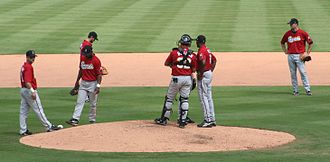
Pitching coach Stan Kyles meets with the Sounds' battery of Justin Lehr and J. C. Boscán on the mound.
The Nashville Sounds Minor League Baseball team has played in Nashville, Tennessee, since being established in 1978 as an expansion team of the Double-A Southern League. They moved up to Triple-A in 1985 as members of the American Association before joining the Pacific Coast League in 1998. With the restructuring of the minor leagues in 2021, they were placed in the Triple-A East, which became the International League in 2022. In the 2024 season, the Sounds' coaching staff was led by manager Rick Sweet and included Al LeBoeuf (hitting), Patrick McGuff (pitching and bullpen), Eric Theisen (hitting), David Tufo (bench), and Ned Yost IV (general).
Six former Sounds players later served as coaches for the team. Wayne Garland of the 1982 starting rotation returned as pitching coach from 1987 to 1988. Don Cooper, who pitched out of the bullpen in 1980, served as pitching coach from 1994 to 1996. Reliever Steve Wilson retired from the Sounds during the 1995 season and became the team's pitching coach. Fred Dabney, a reliever on the 1993 team, returned to coach pitchers from 2012 to 2014. Éric Gagné, who made two major league rehabilitation starts in 2008, served as bullpen coach in 2019. Jim Henderson, a reliever from 2011 to 2012 and in 2014, returned to the Sounds as pitching coach in 2021. Outfielder Gene Roof (1986) and catcher Buddy Pryor (1987) were player-coaches who coached hitting while also playing on the team. Two coaches also managed the Nashville club. Pitching coach Wayne Garland filled in as interim manager for three games in 1988 after the dismissal of manager Jack Lind. Richie Hebner, who was the hitting coach from 1998 to 2000, became the team's manager for the second half of the 2000 season when Trent Jewett was hired as the Pittsburgh Pirates' third base coach. Four coaches have been selected to participate in the Triple-A All-Star Game: Stan Kyles (2006), Rich Gale (2011), Bob Skube (2014), and Rick Rodriguez (2017). (Full article...)
More did you know
- ...that on Mother's Day, May 14, 2006, the Louisville Slugger Company produced more than 400 pink baseball bats for game use by more than 50 professional baseball players?
- ... that the 12–6 curveball gets its name from the way the pitch breaks downward, looking like it moves from the number 12 to the number 6 on a clock?
- ... that Lou Marson hit his first major league home run on the final day of the Philadelphia Phillies’ World Series-winning 2008 season?
- ...that Jerry Dybzinski's baserunning error in game four of the 1983 American League Championship Series ultimately cost the Chicago White Sox both the game and the series?
- ... that Nick Castellanos received a $3.45 million signing bonus from the Detroit Tigers, the highest ever for a player not drafted in the first round in the Major League Baseball Draft?
Sports portals
Selected picture

| Credit: George Grantham Bain Collection |
John Joseph Evers (July 21, 1883 – March 28, 1947) was a Major League Baseball player and manager. He was elected to the Baseball Hall of Fame by the Veterans Committee in 1946. He was born in Troy, New York. He is famously featured in the poem Baseball's Sad Lexicon along with teammates Joe Tinker and Frank Chance.
Associated Wikimedia
The following Wikimedia Foundation sister projects provide more on this subject:
-
Commons
Free media repository -
Wikibooks
Free textbooks and manuals -
Wikidata
Free knowledge base -
Wikinews
Free-content news -
Wikiquote
Collection of quotations -
Wikisource
Free-content library -
Wikiversity
Free learning tools -
Wiktionary
Dictionary and thesaurus
More portals
- Portals with triaged subpages from June 2018
- All portals with triaged subpages
- Portals with no named maintainer
- Automated article-slideshow portals with 51–100 articles in article list
- Automated article-slideshow portals with 501–1000 articles in article list
- Random portal component with 41–50 available subpages
- Automated article-slideshow portals with 201–500 articles in article list
- Random portal component with 11–15 available subpages
- Random portal component with 21–25 available image subpages







